Opinel is a French knife company founded in 1890 and headquartered in Chambéry, Savoie, France, headed by Joseph Opinel, François Opinel, and Denis Opinel. Made in the heart of French Alps, the Opinel knives are long-lasting, robust, and efficient, crafted with durability, beauty and simplicity for the last 130 years.
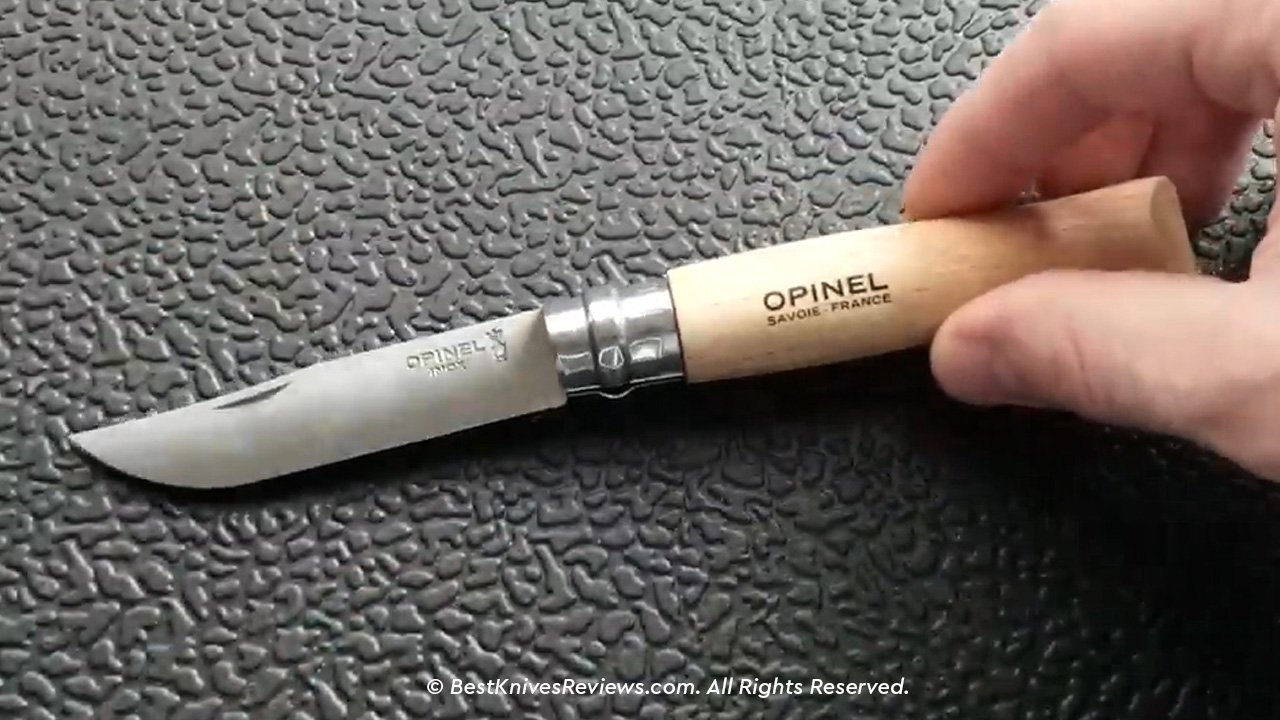
Opinel No 8 Review
Opinel No 8 Prices |
||
|---|---|---|
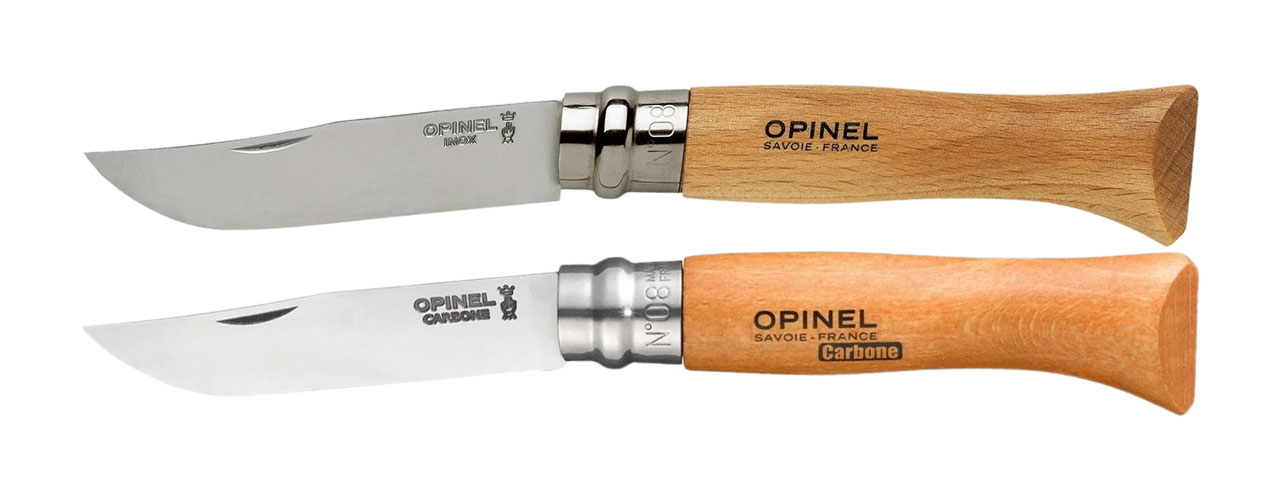 |
 |
Check Price at Blade HQ |
 |
Check Price at Chicago Knife Works | |
Opinel No 8 is a 7.5” folding knife with a 3.25” blade length and a 4.25” handle length featuring 12C27 Sandvik stainless steel blade, beech wood handle, locking safety ring, and a brown leather belt sheath. It weighs only 1.6 oz. The Opinel No 8 is comprised of five elements: the wooden handle, the steel collar around the pivot, a pin to keep the collar in place, and the rotating virobloc locking ring that fits over the steel collar.
Summary of Opinel No 8 specs:
First Impressions of Opinel No 8
The Opinel No 8 came in a simple brown bag with plain branding on it. The packaging itself speaks volumes of the product’s utility, worth, and price. The $35 mark was probably less for a boxed packaging.
However, we appreciate the simple packaging, since it is decent with no-nonsense type of pack.
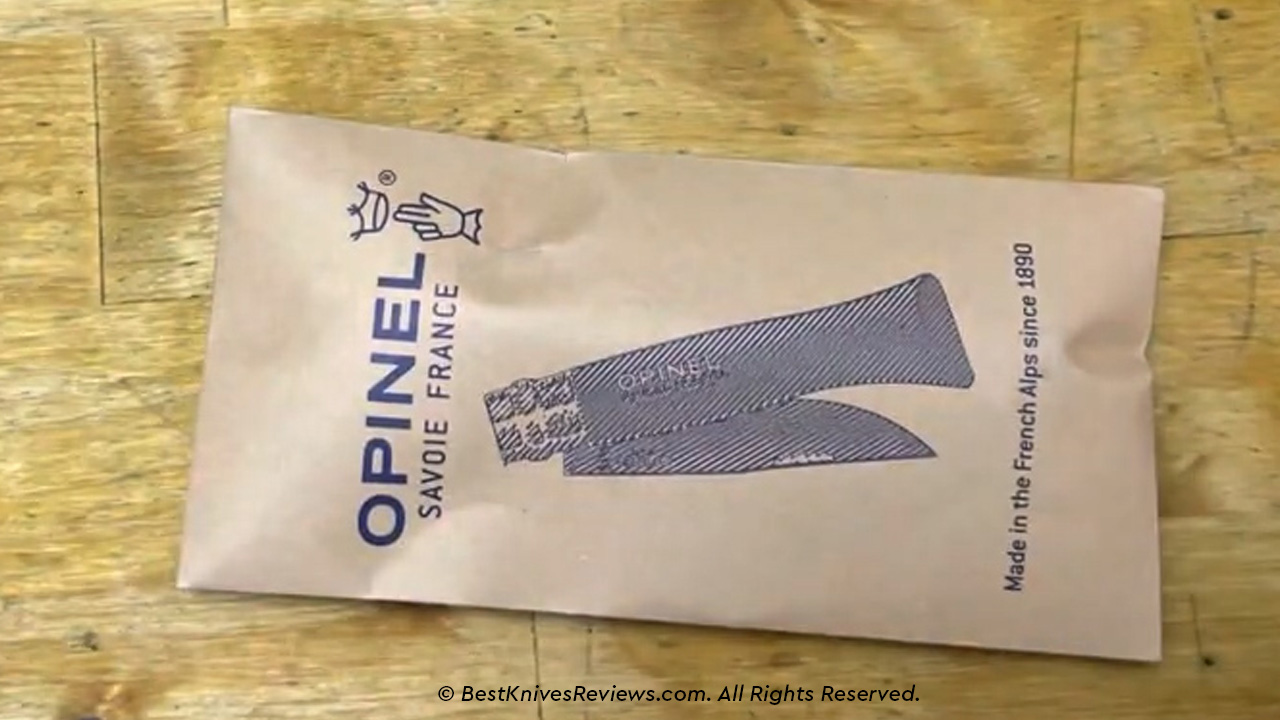
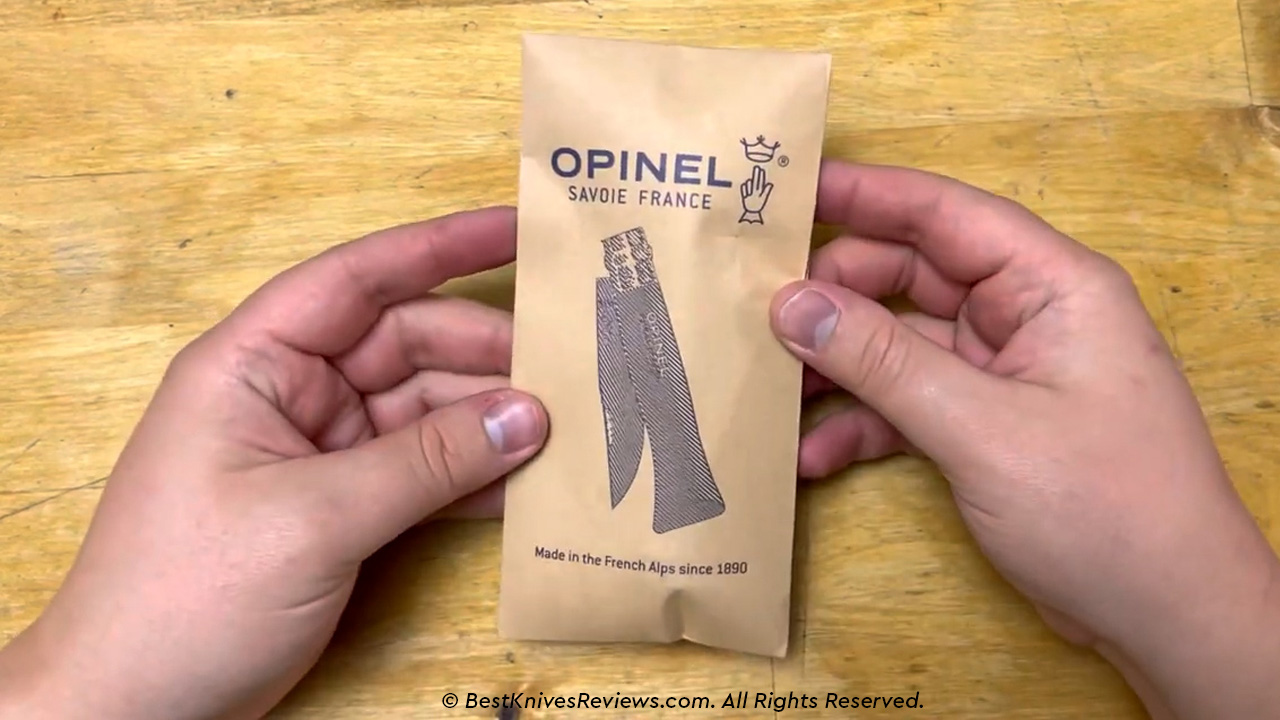
The blade came really sharp right out of the box, and had no scratches or markings on it. It definitely had its factory edge and that perfect satin finish. The handle felt exceptionally smooth and contoured in the hand. And we could not help but feel how lightweight it felt, maybe a bit too light and small for comfort, given the rounded off handle. It feels like it has less edge to hold on to. Yet, it worked ergonomically well. It felt durable and strong.
The locking mechanism works perfectly and flawlessly. You use two hands to slide the blade out. Although, the blade was too obscured to locate it at first sight. You really have to make an effort to slide it out. Nevertheless, it works smoothly. You can use the pivotal bolster lock to lock the blade in place easily. It does not pose any troubles.
The sheath was as expected, which was more like a pouch than a sheath, but fulfilled its purpose. It held the knife in place well, and came with a button lock to secure it in place. You can use the hook to hang it on to your belt. It does not provide many options, since it lacks any belt loops. Simply placing the knife inside the sheath and into the pocket seems like a viable option, even though that was not the purpose of the sheath. But the brown leather does protect the knife from any water damage and prevents any pointy edges protruding out. So I’d say it does its job adequately.
The Blade of Opinel No 8
The blade of Opinel No 8 is a sweeping clip point with a convex grind with minimal branding near the spine. The size of the blade is just 3.25”, which looks too small, but sharp as a razor. The convex grind lines run the entire length of the cutting edge with a blade thickness of just 0.06”. It is also exceptionally lightweight, weighing just 1.6 oz. that you can hardly feel in your hand and while carrying it.

The blade width is also less than 1” at just 0.66”, meaning you can use it to slice small everyday objects. The Sandvik 12C27 stainless steel as a blade material on Opinel No 8 is a good choice, as it goes with the knife geometry, but is considered low-end Swedish martensitic chromium steel, as it contains 13.5% chromium that enhances its tensile strength, corrosion resistance, and edge retention. This blade steel material is commonly used in kitchen knives, hunting knives, fishing knives, ice drills, and skate blades. It has a carbon content of just 0.6%, which improves its hardness and wear and corrosion resistance.
Despite the low carbon content, the Sandvik 12C27 has a hardness level of 56 HRC, which is pretty good for a small folding EDC knife. In addition, it has a great combination of hardness and toughness, which results in a hard steel knife than can easily be sharpened. It is much better for food prep than the carbon steel, since the carbon steel can add a weird taste to the food. It is also relatively inexpensive, considering how cheap the knife is. It is also capable of handling your everyday cutting tasks, so I’d say it is a pretty good steel blade.
The Handle of Opinel No 8
The handle of Opinel No 8 is made of simple rounded beech wood with smooth edges and excellently polished. It also offers decent traction without any gimping, and is a sort of priscine shape with a gentle curve instead of aggressive scalloping or finger grooves. It kind of offers a natural-grip knife when you hold it in your hand in a way that it fits the shape of your fist. It works well in all grips no matter how you hold it; whether you choke it up, backwards, or forwards. The flat spine of the blade allows you to place your index finger or thumb along the thumb ramp for extra control. The flat butt-end of the knife creates a good spot for your thumb in a reverse grip, which is a nice addition.
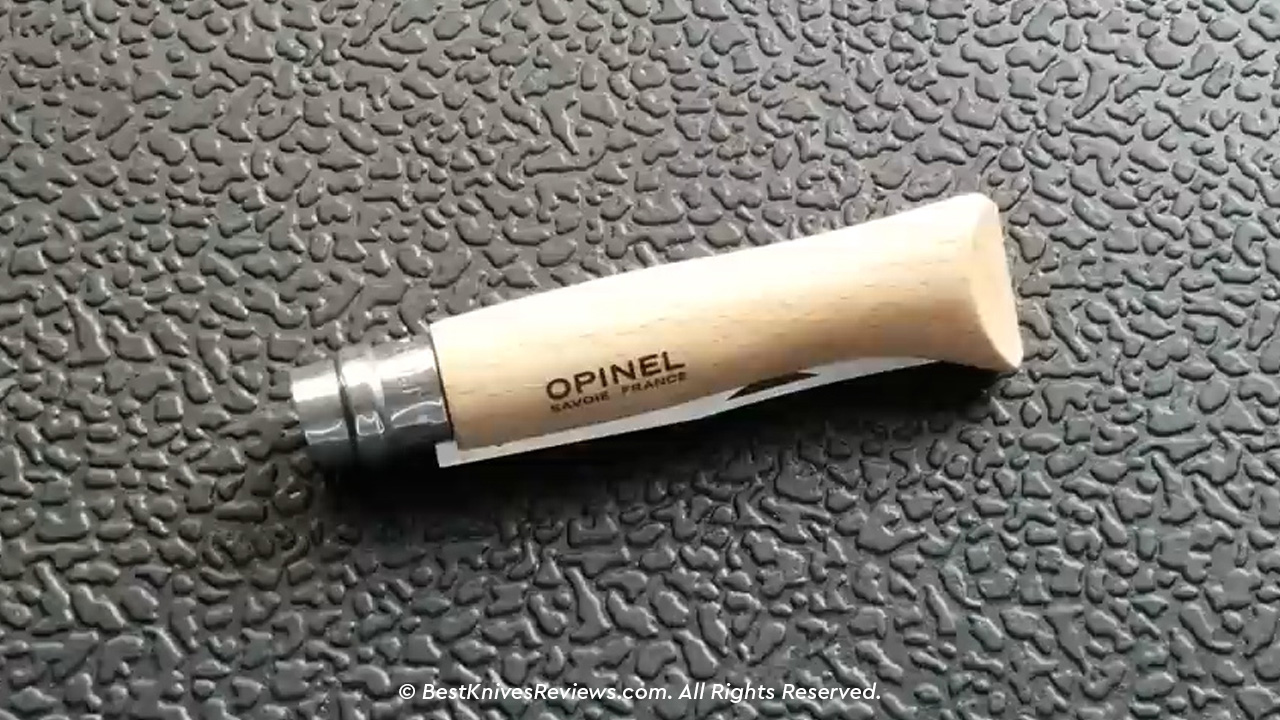
It is also interesting to note that the handle of Opinel No 8 has no pocket clip. It works great ergonomically, but is less than stellar in the pocket. Its too-smooth rounded handle has the tendency to flop over inside the pocket without having a clip to keep it put and balance it. It is also very lightweight, which means you would not notice if it flips over your pocket. However, it is made of durable materials, so it would not get dinged up or scratchy by the keys or other stuff you hold in the pocket.
The beech wood is a popular choice for knife handles, mostly due to its durability, density and strength. However, it lacks in fluidity and flexibility unlike plastic handle materials, which is a given because it is wood. However, the small pores and tight grains of beech wood makes it resistant to wear and tear. It is also important to note that it is not water-resistant, unlike oak wood. So you do not want to leave your Opinel No 8 in the water for too long.
Deployment and Lockup of Opinel No 8
Since the knife opens with a nail mark that means opening it is a two-handed job. You cannot open it with one hand no matter how you try, unlike some other two-handed opening folders. The blade fully hides itself inside the handle, so there is no room to place the tip of your finger to thwart open the blade.
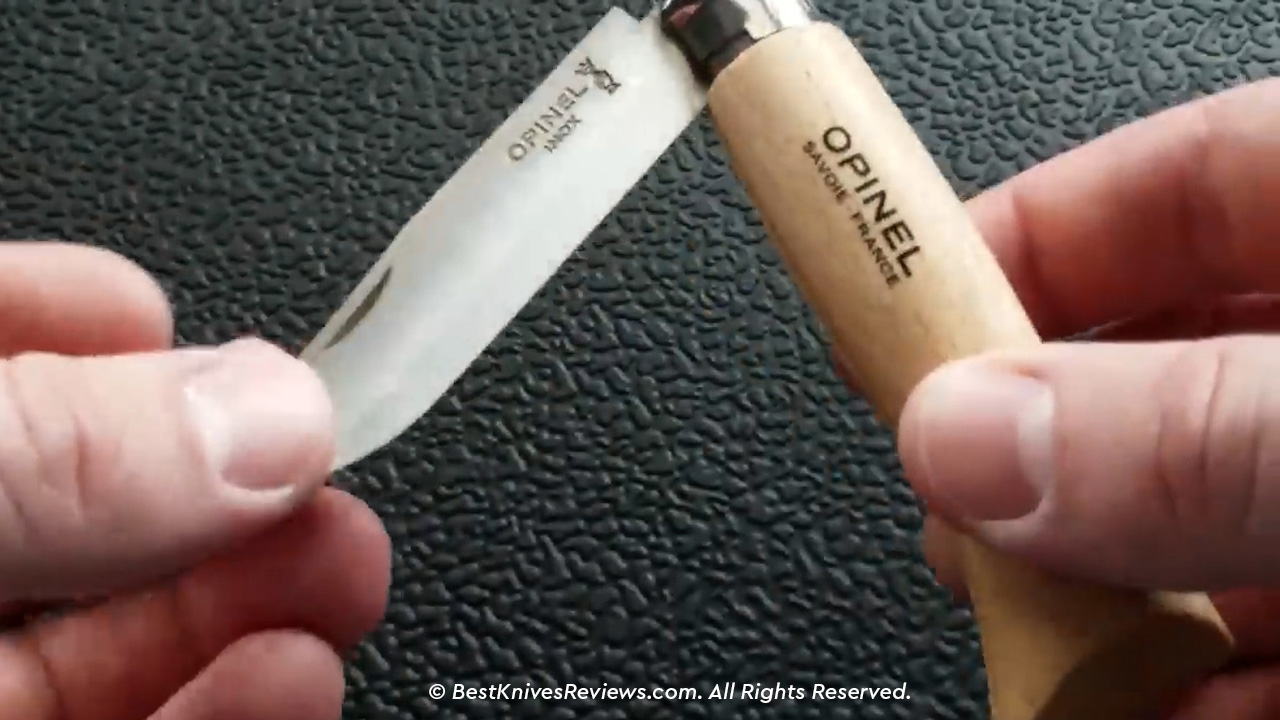
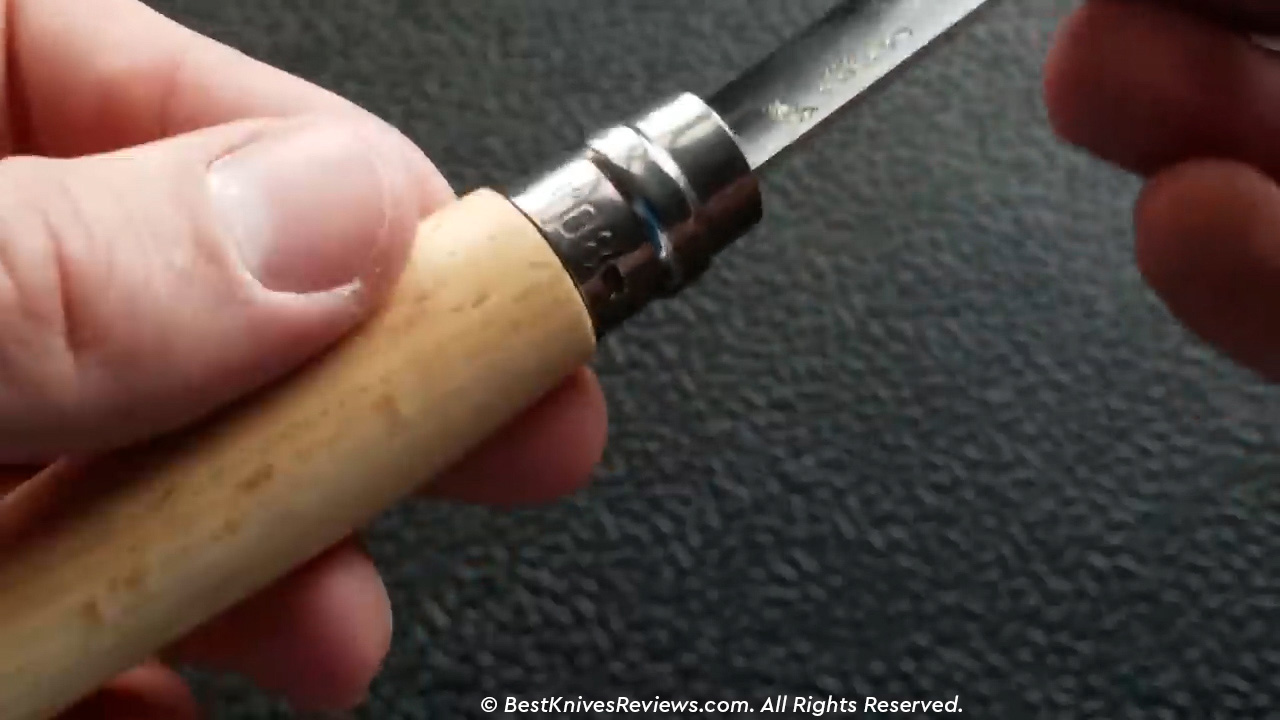
However, it opens effortlessly and smoothly. It has no spring putting tension on the blade, unlike slipjoints. Therefore, it comes out without any struggle. Also, it is not necessary to use the nail mark. You can just pinch the blade and pull it right out. If the wooden handle swallows some, it creates some tightness and hence, has issues opening. But that is only temporary and does not render the knife useless.
The Virobloc locking ring makes the deployment very smooth. You have the option not to use it, but that would make the deployment very uncomfortable. It is basically a ring around the pivot collar of the knife that can be rotated around till it meets the tang of the blade and locks it open or closed.
This is an excellent feature in the Opinel No 8, since it locks the blade in place and you do not have to worry about it disengaging on you. However, locking the blade back is also a two-handed action, so speed is not this knife’s best companion. Two-handed opening and closing means it will take up time to deploy it. However, this deployment mechanism is strong and reliable. It will not fail on you easily. Same is the case with the Bolster locking mechanism.
The Sheath of Opinel No 8
The sheath of Opienl No 8 is brown leather belt sheath with a hook at the top and a button closure. It is pretty simple and small without any belt loops to hang on to. However, the one hook at the top does assist with easy hanging onto wherever you want. You can use it to loop around the belt, or the strap of a backpack.
It is well-made with a nice contrasting stitching and clean branding. The sheath acts more like a pouch than a sheath itself, but functions adequately, although unlike any other knife sheaths we have experienced. Moreover, sheaths usually come with fixed-blade knives for safe carry. Since Opinel No 8 is not a fixed-blade, rather a small folding knife, the purpose of sheath is below expectation. Since the knife is not a quick deployment knife and completely obscures the blade, you can carry it as it is. But then again, it lacks any pocket clip or a lanyard hole, which makes it difficult to carry on its own. The handle is also round with the possibility of it sliding over. That is where the sheath comes in. But the knife would have been better off with a pocket clip instead.
Opinel No 8 Field Test
The Opinel No 8 may not be an ideal carry knife, but it performs great. Its razor sharp blade is ideal for making precise and sharp cuts. It specifically carries kitchen functions really well. We used it as an outdoor kitchen knife, and despite its lightweight and small size, it performed exceptionally well. It was able to peel, chop, dice, and slice vegetables and fruits. It even helped prepare raw meat really well.
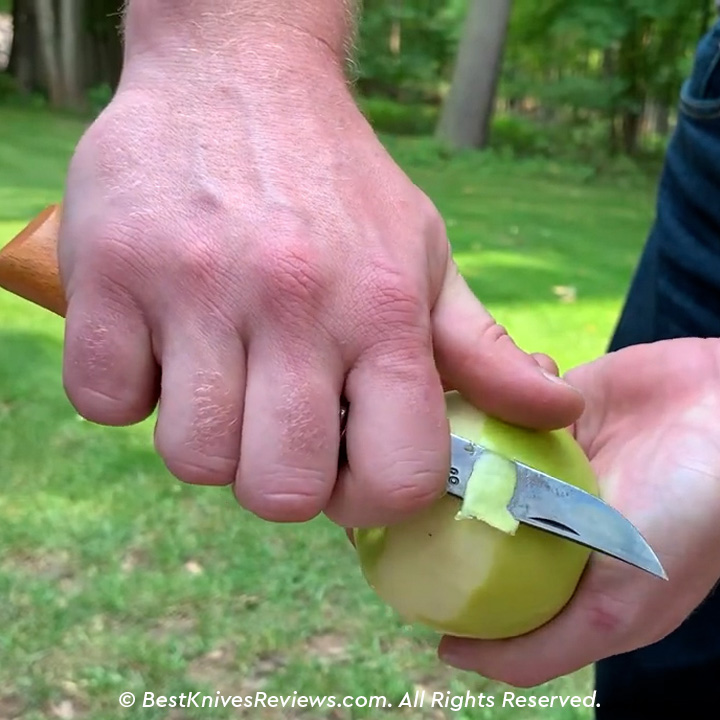
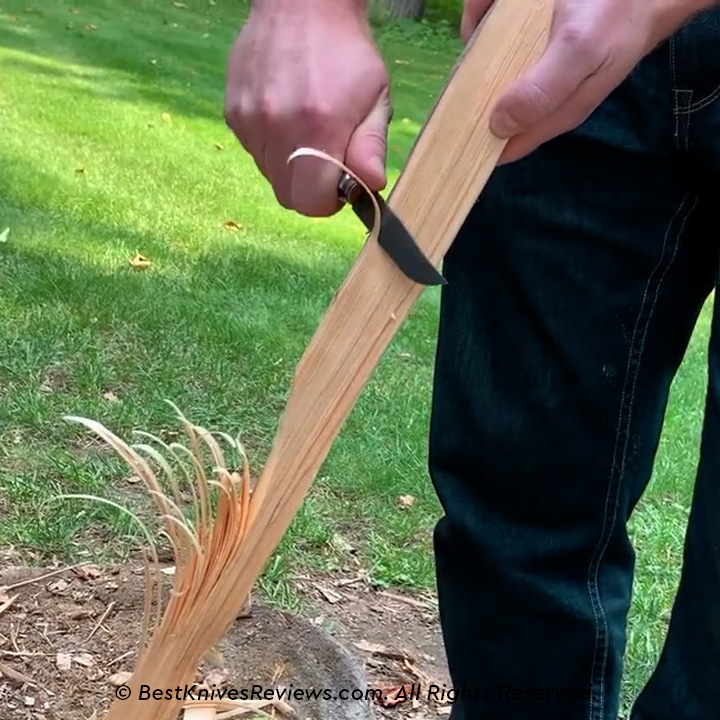
Next up, we tried cutting feather sticks from soft pine wood, and it worked exceptionally well here too. We did not have to put too much pressure on the handle. The blade did its job very smoothly. You can also use its edge to punch through the wood, and it holds its edge really well.
We also used the edge of the knife to cut through the wood, and that also made some really nice cuts. The edge holding and edge retention was really nice on this knife.
The Opinel No 8 cut through raw beef exceptionally well. We used it to cut chunks and strips of meat, and it performed the job flawlessly.
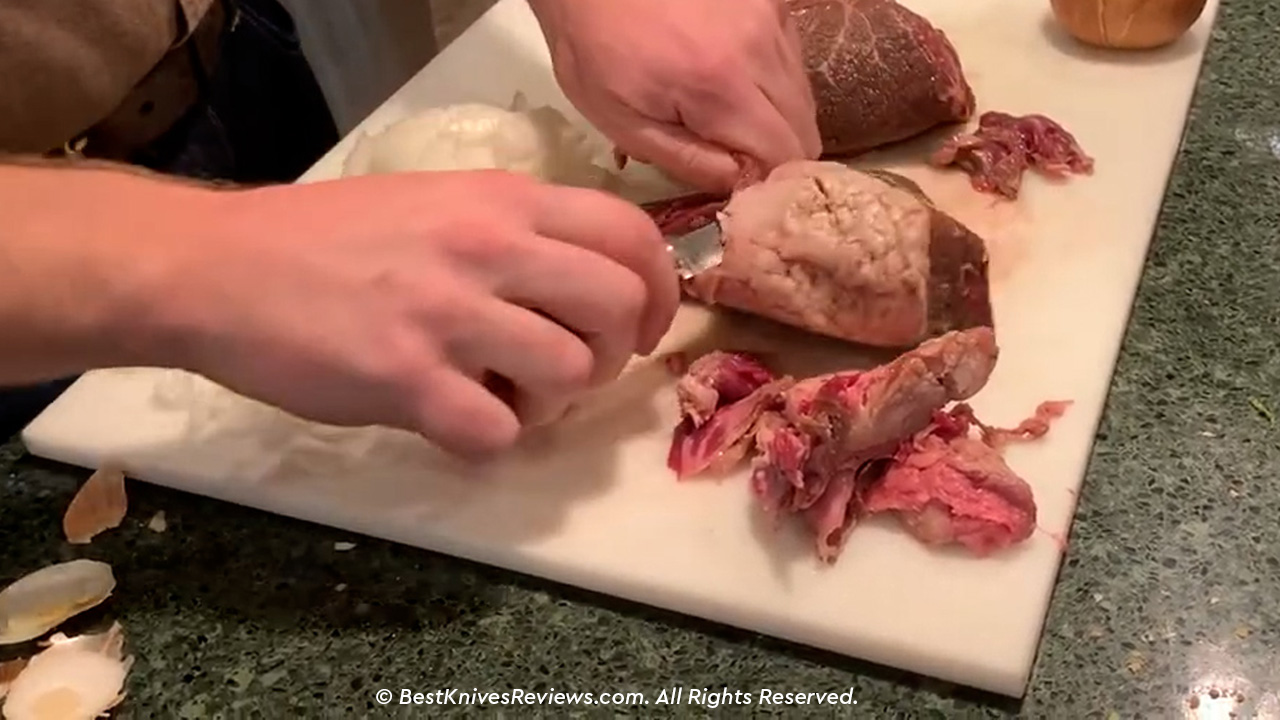
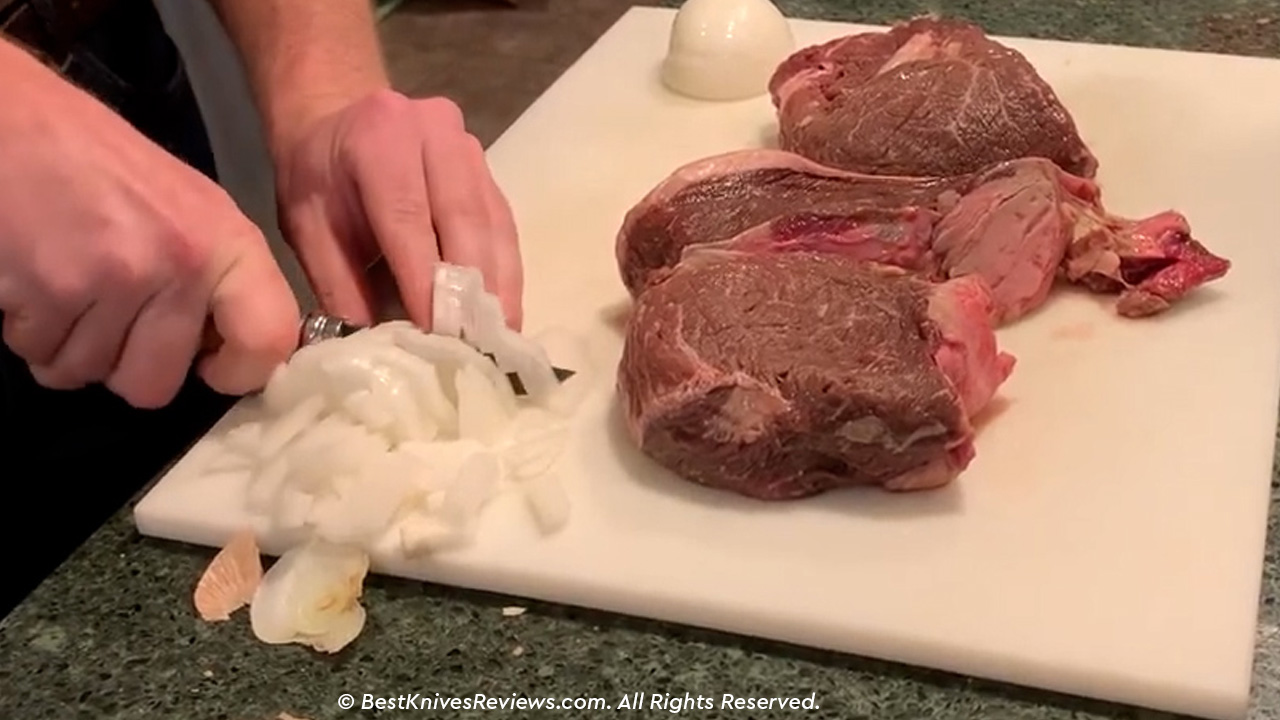
The blade geometry on the Opinel No 8 is really good. It was easy to hold and perform the tasks we did with it, and it remained sharp throughout. It was able to complete the tasks we performed fully without the need to sharpen it.
When it did require sharpening, it was very easy to do so. All you had to do was use the sandpaper, or any specialized sharpening tool you have. The convex grinds were easy to get into and sharpen.
It is also a very useful knife in gardening. We used it to harvest small vegetation in the backyard of our home. We trimmed tomato vines, cucumbers, green beans, and cutting asparagus fronds. It easily sliced through the plants, even those that required delicacy.
The handle did not initially show any signs of wear when left in the water, but if used for extended period, it may show wear and tear. That is the only problem with using it as a kitchen knife. Otherwise, it performs really well in the kitchen no matter what you cut and dice with it.
Pros & Cons of Opinel No 8
PRO’s
Con’s
Comparisons
Opinel No 8 Stainless Steel vs Carbon Steel
The Opinel No 8 we reviewed is that of the stainless Sandvik 12C27 stainless steel. However, it also comes with hard carbon steel variant, which is softer and easy to maintain and sharpen, but is more prone to rusting. The stainless steel blade on the other hand, is harder, more resilient in the face of medium EDC tasks, more resistant to corrosion and requires less maintenance. So you can say that the stainless steel is a clear winner.

When it comes to the level of sharpness, the stainless steel blade also wins in this department. It can easily carry out almost all EDC tasks, including kitchen tasks. The carbon steel may not be ideal for kitchen use because it can easily rust in the presence of water, and adds a weird taste to the fruits and vegetables if you use it to cut them. So the stainless steel blade is probably a better option.
Opinel No 8 vs No 7
Opinels come in various number series from 1 to 13. The no 1 being the smallest, and the no 13 being the largest. However, Opinel stopped manufacturing No 1 and number 11. The range now runs from no 2 to no 13, excluding 11.
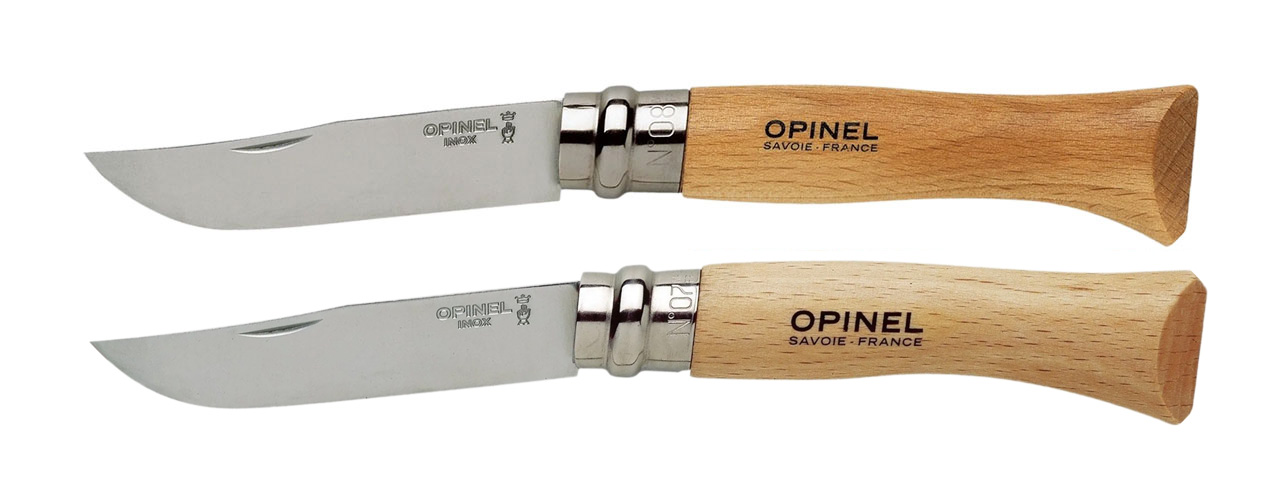
The Opinel no 7 cuts close corners with no 8 with just slight size variation. The no 7 is 7” long as opposed to no 8’s 7.5”. It also weighs lesser at just 1.4 oz. so it feels exceptionally lightweight in the hand and while carrying it. It comes with the same deployment and lockup, and with the wood handle and carbon steel blade. It costs way less than Opinel No 8 at just $16. But it also performs really well with its ultra-thin slicing blade and ergonomic handle.
There is only a slight variation between the two knives, and both perform well.
Opinel No 7 Prices |
||
|---|---|---|
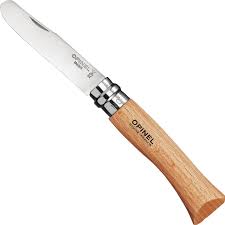 |
 |
Check Price at Blade HQ |
 |
Check Price at Chicago Knife Works | |
Conclusion – Opinel No. 8
The Opinel No 8 review turned out to be positive despite its ultra-lightweight and unconventional knife design. It is a small folding knife with a rounded beech wood handle and comes without a pocket clip but with a brown leather sheath. The sheath acts more like a pouch than a sheath and has no belt loops. It comes with a single hook and a button enclosure.
The Sandvik stainless steel blade on this knife is better than the carbon steel in a way that it is more rust-proof, easier to maintain, sharpen and does better at kitchen tasks. The blade’s edge holding, factory edge, edge retention, toughness and hardness make it a well-defined and balanced blade.
The handle easily fits rounded inside the palm of the hand and holds well. The deployment and lockup is very smooth and will not fail you. However, it is a two-handed opening and closing action. But the blade lock will lock the blade in place that will not disengage on its own. That is a plus point on this knife.
The Opinel No 8 performs really well and passed its field test. It works really well as a kitchen knife and is very good at slicing, dicing, peeling, and harvesting vegetables.
